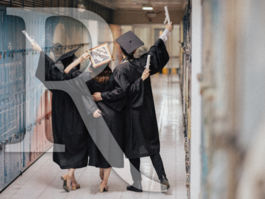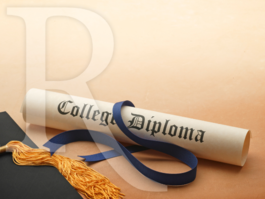College Bubble Bursts After Decades of Extravagance
A Commentary by Michael Barone
Markets work. But sometimes they take time.
That's the uncomfortable lesson that proprietors of America's colleges and universities are learning.
For many years, market forces didn't seem to apply to them. There was a widespread societal consensus that a college education was a good economic investment.
Politicians gave lip service to the idea that everyone should go to college. No one should be stopped by a lack of money.
There was historic precedent. The G.I. Bill of Rights vastly expanded college populations and helped build prosperous post-World War II America. Putting even more through college would make us even more prosperous.
So Congress passed student loan and grant programs to make it easier for people to pay for college and university tuitions. That increased potential higher education revenues.
Surprise! Over the last three decades, tuitions rose faster than the economy grew.
For a long time, that didn't seem to be a problem. College still seemed like a good investment during the quarter century of low-inflation economic growth from 1982 to 2007. You could pay off those loans with earnings increased by your degree.
Meanwhile colleges and universities -- and not just the highly selective ones -- competed for students whose test scores would improve their ratings in the U.S. News College Guide by giving "scholarships" that actually were discounts on the tuition list price.
To attract these students, the educational institutions built fancy dormitories, gymnasiums and student centers. And they vastly increased the number of administrators, to the point where colleges and universities had more administrators than teachers.
Government helped to produce an ever-increasing demand for higher education. So higher education administrators saw no need to compete on price. Higher tuitions just gave your school more prestige.
Now the higher education bubble has burst. The Wall Street Journal reported this week that that the average "tuition discount rate" offered incoming freshmen last fall by private colleges and universities has reached an all-time high of 45 percent.
At the same time, their "sticker price" tuitions have increased by the smallest amount in the last dozen years. Tuitions for in-state students at public four-year colleges and universities also increased by the smallest amount during that period.
Applicants are negotiating bigger discounts than they used to. Market competition has kicked in.
What has happened is that in a recessionary and sluggish economy, potential customers have been figuring out that a college diploma may not be a good investment -- particularly if it entails six-figure college loan debt that cannot be discharged in bankruptcy.
The Millennial Generation that voted so heavily for Barack Obama -- 66 to 32 percent in 2008, 60 to 37 percent in 2012 -- has had a hard time finding jobs, even with diplomas in hand. Especially if their degrees are in gender studies or similar fields beloved of academics.
In even worse condition are those students who never get a degree, a disproportionate number of whom are blacks and Hispanics admitted under affirmative action programs who prove unable to keep up with the pace of instruction at schools where most students enter much better prepared.
We see in higher education something like what we saw in housing. Government programs aimed at increasing college education and homeownership, particularly among minorities, turn out to hurt many of the intended beneficiaries.
The intentions of the people who created these programs were good. The results -- well, not so much.
Home ownership is a good thing generally, but it's not good for everybody. The young and transient, for example, are often better off renting.
Higher education is a good thing generally too, but again not for everyone. People whose talents are more artisanal than academic are often better off getting a job or vocational training than seeking a degree that guarantees them student loan debt but not a job.
College and university administrators are not used to being disciplined by market forces. For years, they thought they were above all that.
Many got into the habit of producing a product that didn't serve their consumers' interests well. In a prosperous and growing economy, there seems to be no penalty for doing so.
In more straitened circumstances, they are discovering that, sooner or later, markets work. Their old business model is no longer working.
Colleges and universities have been doing a good job of meeting their administrators' needs. Now, in the new normal economy, they're scrambling to serve society's needs, as well.
Michael Barone, senior political analyst for The Washington Examiner (www.washingtonexaminer.com), is a resident fellow at the American Enterprise Institute, a Fox News Channel contributor and a co-author of The Almanac of American Politics. To find out more about Michael Barone, and read features by other Creators writers and cartoonists, visit the Creators Syndicate Web page at www.creators.com.
COPYRIGHT 2013 THE WASHINGTON EXAMINER
DISTRIBUTED BY CREATORS.COM
See Other Political Commentaries.
See Other Commentaries by Michael Barone.
Views expressed in this column are those of the author, not those of Rasmussen Reports. Comments about this content should be directed to the author or syndicate.
Rasmussen Reports is a media company specializing in the collection, publication and distribution of public opinion information.
We conduct public opinion polls on a variety of topics to inform our audience on events in the news and other topics of interest. To ensure editorial control and independence, we pay for the polls ourselves and generate revenue through the sale of subscriptions, sponsorships, and advertising. Nightly polling on politics, business and lifestyle topics provides the content to update the Rasmussen Reports web site many times each day. If it's in the news, it's in our polls. Additionally, the data drives a daily update newsletter and various media outlets across the country.
Some information, including the Rasmussen Reports daily Presidential Tracking Poll and commentaries are available for free to the general public. Subscriptions are available for $4.95 a month or 34.95 a year that provide subscribers with exclusive access to more than 20 stories per week on upcoming elections, consumer confidence, and issues that affect us all. For those who are really into the numbers, Platinum Members can review demographic crosstabs and a full history of our data.
To learn more about our methodology, click here.



